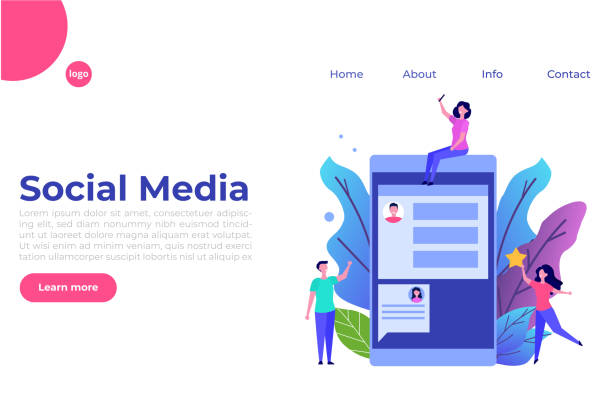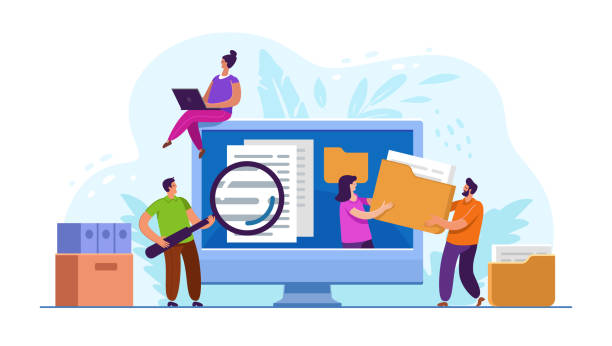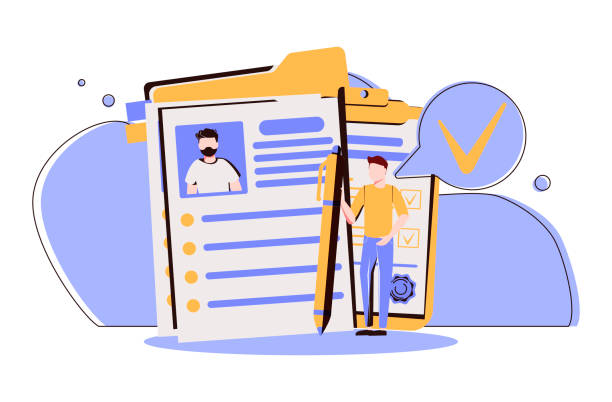Introduction to Secure Website Design and Its Importance

In today’s digital world, where information is exchanged at an unprecedented speed across the web, secure website design is no longer an option, but a vital necessity.
This process includes a set of measures and best practices to protect a website and user information against cyber attacks, unauthorized access, and data breaches.
The main goal in #securewebsitedesign is to create a #trustworthy online environment where users can safely share their information and conduct financial transactions.
Without implementing security principles, websites become easy targets for #hackers who can access sensitive data, bring down the website, or even use it for other attacks.
Imagine a business website losing its customers’ bank card information or a news website seeing its content altered due to a cyber attack; the consequences of such incidents can be catastrophic.
Loss of customer trust, heavy legal penalties, and irreparable damage to brand reputation are just some of the results of neglecting cybersecurity.
Therefore, learning and implementing cybersecurity standards in the early stages of website design is of utmost importance.
This approach not only reduces long-term costs but also provides a secure foundation for sustainable growth and development.
This descriptive and educational introduction demonstrates why every business, from small to large, should prioritize secure website design.
Did you know that 94% of a company’s first impression is related to its website design?
Rasaweb helps you create the best first impression by offering professional corporate website design services.
✅ Create a professional and trustworthy image for your brand
✅ Easier attraction of potential customers and improvement of online presence
⚡ Get free consultation for corporate website design
Common Web Security Threats and Countermeasures

Understanding common threats is the first step in secure website design and effective defense against them.
Today, websites face various types of cyber attacks, each of which can cause serious damage.
One of the most common threats is SQL Injection attacks, where attackers inject malicious SQL code into website input fields to gain access to the database, modify, or delete information.
The way to counter it is by using Prepared Statements and parameterizing queries.
Another threat is XSS (Cross-Site Scripting) attacks, which allow attackers to inject malicious code into web pages to steal user information or perform unauthorized activities.
To counter XSS, thorough input validation and output encoding are essential.
CSRF (Cross-Site Request Forgery) attacks are also a type of attack where the attacker tricks the user into submitting an unwanted request to the website without their knowledge.
Using CSRF tokens and Referer checks can neutralize these attacks.
Additionally, DDoS (Distributed Denial of Service) attacks aim to take a website offline by sending a large volume of malicious traffic, which for secure website design must be countered using Web Application Firewalls (WAF) and DDoS protection services.
Poor session management and flaws in access control can also allow attackers to penetrate.
This specialized and guiding section emphasizes the importance of identifying and implementing defensive solutions against these threats for any website seeking stability and security.
Fundamental Principles of Secure Website Design

Secure website design is based on fundamental principles and concepts, the observance of which guarantees resistance against cyber attacks.
One of these principles is the “Least Privilege” principle, which means that every user or system should only be equipped with the minimum necessary access to perform their tasks, and no more.
This prevents potential vulnerabilities arising from extensive access.
“Defense in Depth” is another principle that emphasizes the necessity of implementing multiple layers of security; in such a way that if one security layer fails, the next layer can protect the system.
This approach is crucial for secure and resilient website design.
“Secure Defaults” means that software and systems should be configured by default in the most secure state possible, and then, if necessary, access should be expanded, not vice versa.
Also, “Separation of Privileges” means that for a sensitive operation, the cooperation of several sections or users is required to reduce the risk of misuse.
“Economy of Mechanism” also refers to the fact that security mechanisms should be as simple and small as possible to reduce the probability of errors and vulnerabilities within them.
These educational and descriptive principles provide the necessary framework for web developers and administrators to design websites with a secure foundation and ultimately achieve secure and stable website design.
These fundamental concepts form the cornerstone of any successful cybersecurity strategy, and neglecting them can expose the website to serious risks.
Table 1: Fundamental Principles of Secure Website Design

| Security Principle | Brief Explanation | Importance in Secure Website Design |
|---|---|---|
| Least Privilege | Users and systems are equipped only with the minimum necessary access. | Reduces the scope of damage in case of a breach and prevents unauthorized access. |
| Defense in Depth | Implementation of multiple security layers. | Increases system resistance to attacks despite potential single points of failure. |
| Secure Defaults | Default configuration of systems in the most secure state possible. | Reduces risk from incorrect initial configurations. |
| Separation of Privileges | Requires cooperation of multiple parties for sensitive operations. | Prevents misuse by a single individual or system. |
| Economy of Mechanism | Security mechanisms should be as simple and small as possible. | Reduces the likelihood of errors and vulnerabilities in complex implementations. |
Worried about losing customers because you don’t have a professional e-commerce website?
With e-commerce website design by Rasaweb, forget these worries!
✅ Significant increase in sales and conversion rate from visitor to customer
✅ Professional and user-friendly design that builds customer trust
⚡ Get free consultation from Rasaweb
The Developer’s Role in Secure Website Design

Web developers are the backbone of secure website design and bear immense responsibility in preventing vulnerabilities.
This guiding and specialized section addresses some of the most important measures a developer must take to ensure website security.
The first step is Input Validation.
Any data received from the user must be carefully checked and sanitized to prevent the injection of malicious code or invalid data.
Using secure frameworks and libraries, instead of writing security code from scratch, can significantly increase security.
Session Management is also highly important; Session IDs should be random and unpredictable, transmitted via HTTPS, and expire after a specific period.
In secure website design, passwords should never be stored in plain text; instead, strong hashing functions (like bcrypt or Argon2) along with salt should be used.
Proper error management is also key; generic error messages, rather than detailed system information, should be displayed to the user to prevent the disclosure of sensitive information.
Furthermore, developers should continuously update their knowledge of new threats and best security practices and utilize static and dynamic code analysis tools to identify vulnerabilities in their code.
Observing these points not only helps increase website security but also leads to a safer web browsing ecosystem for all users.
Tools for Website Security Assessment

After implementing the principles of secure website design, the next step is continuous evaluation and identification of potential weaknesses.
Fortunately, there are numerous tools to assist in this process, some of which are discussed in this specialized and analytical section.
Web Vulnerability Scanners such as OWASP ZAP and Burp Suite are powerful tools that can automatically scan a website to identify known vulnerabilities like SQL Injection, XSS, and CSRF.
These tools, by simulating common attacks, provide detailed reports of potential weaknesses, helping developers to fix them.
Additionally, Static Application Security Testing (SAST) tools like SonarQube analyze the application’s source code without executing it to identify insecure coding patterns.
This method is highly effective for finding security flaws, especially in the early stages of development.
On the other hand, Dynamic Application Security Testing (DAST) tools like Acunetix, by executing the application and sending various requests, examine the system’s behavior against malicious inputs.
These tools complement SAST and can discover vulnerabilities that are not apparent during the coding phase.
Penetration Testing, often performed by security professionals, involves simulating real attacks on the system to identify weaknesses.
This analytical approach is vital and ensures that your secure website design is also resilient against real-world attack scenarios.
The combined use of these tools and methods provides a comprehensive approach to assessing and strengthening website security.
Identity and Access Management in Secure Website Design

Identity and Access Management (IAM) is a key pillar in secure website design.
This educational and specialized section addresses methods for ensuring user identity and controlling their access to system resources.
The first and perhaps most important aspect is strong authentication.
The system must ensure that a user claiming a specific identity is indeed that person.
Using complex passwords, enforcing password changes at regular intervals, and implementing Multi-Factor Authentication (MFA) are effective solutions in this regard.
MFA, by adding extra security layers, such as a code sent to a mobile phone or a fingerprint, prevents unauthorized access even if the password is compromised.
After authentication, it’s time for authorization.
This means that each user or group should only have access to the resources and functionalities they need to perform their tasks.
Models such as Role-Based Access Control (RBAC) and Attribute-Based Access Control (ABAC) are applicable in this area.
Secure session management is also crucial; user sessions must have a defined expiration time and be completely invalidated after the user logs out.
Additionally, session tokens must be transmitted over secure channels (such as HTTPS) and protected against attacks like Session Hijacking.
Precise implementation of these concepts in secure website design prevents attackers from infiltrating through compromised user accounts and significantly enhances overall system security.
Database and Infrastructure Security

Databases and server infrastructures are the heart of any website, and protecting them in the secure website design process is of vital importance.
This specialized and descriptive section addresses essential measures to ensure the security of these components.
Database security includes encrypting sensitive data, both in transit and at rest.
Using secure protocols like SSL/TLS for database communications and implementing column-level encryption or full disk encryption can prevent information disclosure even in the event of unauthorized server access.
Applying the principle of least privilege to database access means that the web application should connect to the database with only the minimum possible privileges and should never use the root/admin account.
Additionally, secure configuration of database servers, including removing unnecessary services, closing unnecessary ports, and regularly updating the Database Management System (DBMS), is crucial.
Regarding infrastructure, using Web Application Firewalls (WAF), which monitor incoming and outgoing traffic to identify and block web attacks, is highly effective.
Regularly updating the server operating system, software used (such as web server, programming language, and libraries), and implementing security patches are of high importance.
Furthermore, continuous monitoring of logs to identify suspicious activities and implementing Intrusion Detection Systems (IDS) and Intrusion Prevention Systems (IPS) significantly contribute to a secure website design.
These comprehensive measures provide robust defensive layers against cyber threats.
Tired of your company’s website not being seen as it should be and losing potential customers? Solve this problem forever with professional and effective website design by Rasaweb!
✅ Increase brand credibility and gain customer trust
✅ Attract targeted sales leads
⚡ Contact us now for a free consultation!
Table 2: Best Practices for Database Security

| Security Measure | Description | Benefit |
|---|---|---|
| Data Encryption | Encrypting sensitive data at rest and in transit. | Protects information even if the disk is accessed without authorization. |
| Least Privilege Principle | Setting minimum necessary access for applications and users to the database. | Limits the scope of damage in case of application intrusion. |
| Secure Configuration | Disabling unnecessary services and closing insecure ports. | Reduces entry points and potential vulnerabilities. |
| Regular Updates | Installing patches and security updates for the DBMS. | Fixes known vulnerabilities in the software. |
| Log Monitoring | Continuously reviewing database logs to identify suspicious activities. | Prompt detection of intrusion attempts and attacks. |
| Regular Backups | Creating regular and secure backups of data. | Enables data recovery in case of attack or system failure. |
Continuous Updates and Maintenance of Website Security

It is often thought that secure website design is a one-time project that ends with the launch of the website, but this perception is completely incorrect.
Security is a continuous and ongoing process that requires constant monitoring, updating, and maintenance.
This news and guidance section addresses the importance of these measures.
Cyber threats are evolving, and new methods of infiltration are discovered every day; therefore, your website must also keep its defenses up-to-date with these developments.
One of the most important aspects is regular updates of all components; from the Content Management System (CMS) like WordPress or Joomla to plugins, themes, programming libraries, and even the server operating system, all must be updated to the latest stable and secure versions.
Many successful attacks result from known vulnerabilities in older software versions that can be fixed with a simple update.
Furthermore, continuous monitoring of website activities through log monitoring systems and Intrusion Detection Systems (IDS) can identify early signs of attacks or suspicious activities.
Having an Incident Response Plan to deal with potential attacks and rapidly recover the system is also of high importance.
Periodic security audits and penetration tests, conducted regularly, can uncover new weaknesses and ensure that the standards of secure website design are still being met.
Neglecting these matters can turn a website that was initially designed securely into an easy target for attackers.
Frequently Asked Questions
| Question | Answer |
|---|---|
| What is secure website design? | Secure website design is a process in which websites are built with security principles in mind to be resistant to cyber attacks and protect user and business information. |
| Why is secure website design highly important? | To prevent unauthorized access to data, sensitive information leaks, malware attacks, loss of user trust, damage to business reputation, and legal consequences of data breaches. |
| What are the most common website vulnerabilities? | SQL Injection, Cross-Site Scripting (XSS), Cross-Site Request Forgery (CSRF), broken authentication and session management, and sensitive data exposure. |
| How can SQL Injection attacks be prevented? | Using Prepared Statements with bound parameters (Parameterized Queries), Input Validation, and limiting database access. |
| What are the methods to counter XSS (Cross-Site Scripting) attacks? | User input validation, output encoding before displaying in HTML, and using Content Security Policy (CSP). |
| What is the role of HTTPS in website security? | HTTPS encrypts the communication between the user’s browser and the website server using an SSL/TLS certificate, preventing eavesdropping, tampering, or forgery of data. |
| What are the best practices for managing user passwords? | Enforcing strong passwords (a combination of letters, numbers, and symbols), hashing passwords instead of direct storage (with strong algorithms like bcrypt), and enabling Two-Factor Authentication (2FA). |
| What is the importance of User Input Validation? | Input validation prevents malicious or unexpected data from entering the system, which can lead to vulnerabilities such as SQL Injection or XSS. |
| What is the impact of regular security reviews and audits on website security? | These reviews help identify vulnerabilities and security weaknesses early, allowing them to be fixed before they can be exploited. |
| What is the application of Web Application Firewall (WAF) in secure website design? | WAF acts as a protection layer between the user and the website, analyzing incoming traffic and identifying and blocking common web attacks such as SQL Injection and XSS. |
And other advertising services from Rasaweb Advertising Agency
- Smart Direct Marketing: An effective tool for customer acquisition with the help of Google Ads management.
- Smart Sales Automation: A professional solution for increasing click-through rates, focusing on using real data.
- Smart Content Strategy: A dedicated service for growth and increasing click-through rates based on user experience customization.
- Smart Sales Automation: An effective tool for increasing sales with the help of Google Ads management.
- Smart UI/UX: A professional solution for user interaction focusing on optimizing key pages.
And over hundreds of other services in the field of internet advertising, advertising consultation, and organizational solutions
Internet Advertising | Advertising Strategy | Advertorial
Resources
Comprehensive Guide to Secure Website Design
Key Website Security Tips
Identifying Common Web Vulnerabilities
The Importance of SSL/TLS in Website Security
Are you looking for a big leap in your online business? ? Rasaweb Afarin Digital Marketing Agency offers specialized services including WordPress website design, SEO, and digital advertising, providing smart solutions for your growth and visibility in the online space. With us, the digital future of your business is brighter.
📍 Tehran, Mirdamad Street, next to Central Bank, Southern Kazerun Alley, Ramin Alley No. 6

